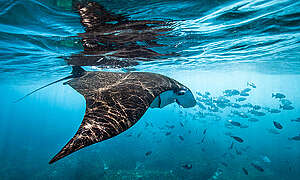We are standing at a pivotal moment in history. A global movement unlike anything we’ve seen before is demanding governments take action to address the climate emergency. Young people, inspired by Swedish activist Greta Thunberg and many others, are at the forefront of a passionate, growing movement that is grounded in science. It is their future that is being shaped by the decisions being made now. It is their future that governments are toying with as they deliberate over vague promises and voluntary commitments.
The science could not be clearer: at most, we have 10 years to avoid crossing the 1.5°C heating threshold. The consequential increase in existential risks to nature and people is undeniable. The most recent report from 11,000 scientists across 153 countries said that without swift action, ‘untold human suffering’ is unavoidable.
The impacts, which we’re still grappling to comprehend, will be widespread and far-reaching. Sea level rise will redraw the coastlines of many countries over the course of the coming century, with devastating research recently published in the academic journal Nature Communications roughly tripling the number of people estimated to be at risk. Nearly three quarters of the communities newly estimated to be vulnerable live in eight Asian countries, with the biggest chunk in China. More than 10% of the current populations of nations including Bangladesh, Vietnam, and many Small Island Developing States are among the most at risk, threatened by chronic coastal flooding or permanent inundation.
Sea level rise is just one of the major ocean impacts of human emissions of CO₂ into the atmosphere. The ocean is the beating blue heart of this planet—essential to each and every one of us.
Increasing levels of CO₂ are causing ocean heating, acidification and deoxygenation, leading to changes in oceanic circulation and chemistry, rising sea levels, increased storm intensity, and changes in the diversity and abundance of marine species.
Two recent and substantive reports—the IPCC’s Special Report on the Ocean and Cryosphere and the IPBES Global Assessment Report on Biodiversity and Ecosystem Services—set out the complex interplay between ocean and climate. They explain not only the impacts of rising greenhouse gasses on the ocean, but how ocean and marine life carries out essential ecosystem functions which, among other things, provide food, sequester and store carbon, and generate oxygen.
This report draws on this research and much of the recent science. It sets out how, by protecting at least 30% of the ocean in a network of ocean sanctuaries, we can build resilience in ocean ecosystems so they can better withstand rapid changes, and help mitigate climate change by promoting carbon sequestration and storage.
Building a global network of ocean sanctuaries in both coastal waters and international waters will help buffer against both management and environmental uncertainty.
2020 is a crucial year for protecting our oceans. There is the opportunity for countries to agree to a new Global Ocean Treaty at the UN, and at the Convention on Biological Diversity nations must pledge to protect at least 30% of the oceans by 2030. There is also a climate summit where all countries must agree to increase their action to reduce the gases that cause climate change. Leaders have to implement effective ocean protection at a scale commensurate to the ecological threats, and commit to strengthening national climate plans and associated Nationally Determined Contributions (NDCs) in line with the 1.5°C limit.
The science is inescapable and the urgent need for action is undeniable. To avert reaching further looming ecological tipping points, governments must heed the calls of their citizens and act now.


